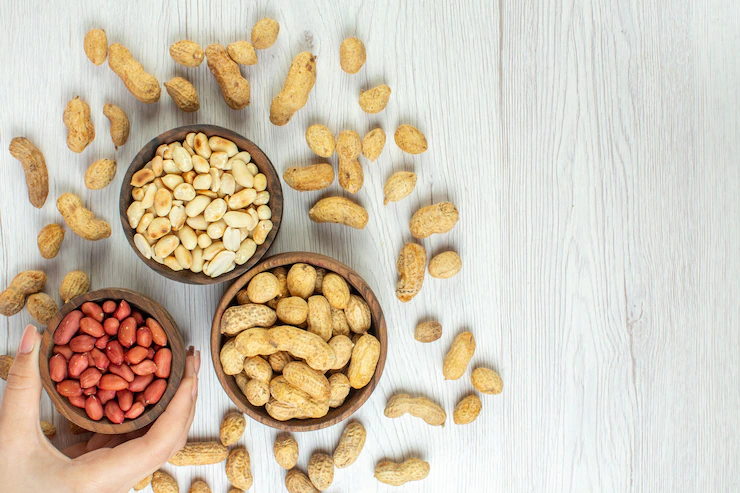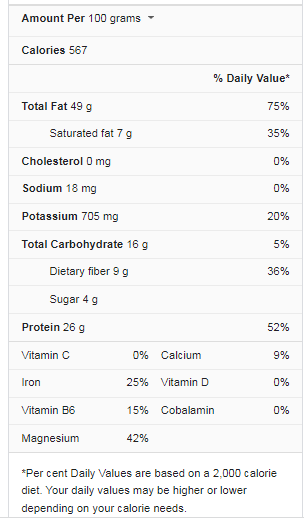Peanuts provide healthy calories due to their high protein and fat content. On the other hand, its antioxidants minimize oxidative stress, lower blood sugar, and promote heart health. Peanuts are a low-cost, readily available legume high in vitamins, trace elements, and minerals. Peanuts can be consumed raw as a snack or cooked into several recipes, ranging from a high-calorie breakfast to a post-workout drink to a dessert. Peanuts’ calories are beneficial to one’s health and fitness. It is high in fat, protein, and fiber, making it a nutritious food.
Salted peanuts are roasted in oil and packaged in retail-size plastic bags or hermetically sealed cans. Peanuts that have been dry roasted and salted are also widely available. Peanut butter is primarily utilized in the home, but massive amounts are also used in the commercial production of sandwiches, confectionery, and bakery goods. Cooked peanuts are a snack made from raw, unshelled green peanuts that have been boiled in brine. They are popular in the southern United States, where most peanuts are cultivated.
Peanuts are also often used to feed garden birds. Peanut oil, seed, and feed are made from low-grade or culled peanuts that are not fit for the food market, though some pet hookbill owners shun them for this reason. Peanuts are used in a range of industrial applications. Peanut oil makes paint, varnish, lubricating oil, leather treatments, furniture polish, pesticides, and nitroglycerin. Many cosmetics contain peanut oil and its derivatives, and soap is created from saponified oil. The oil’s protein content is employed in producing various textile fibers.
Peanuts Nutrition Facts
How to Use Peanuts?
Raw, blanched, roasted, boiled, fried, powdered, or processed into peanut butter, and peanuts can be eaten in various ways. The skin contains many antioxidants and phytochemicals; therefore, eating them with thin, papery skin is the most nutritionally advantageous. Add extra peanuts to your diet, whether in peanuts or peanut butter.
Here are some ways to use peanuts in a variety of dishes:
- Bake peanuts into cookies or pies.
- Make a peanut butter and banana sandwich.
- Add peanut butter to hummus.
- Top your yogurt with peanuts.
- Toss peanuts in a salad.
- Add peanuts to your stir fry or noodles dish.
- Mix peanuts into a trail mix.
- Dip spring rolls into Thai peanut sauce.
What are the Health Benefits of Peanuts?
Lower Diabetes Risk
Peanuts are a low-glycemic food, so they won’t cause your blood sugar levels to jump. Eating peanuts has been found in studies to reduce the risk of type 2 diabetes in women.
Reduce Inflammation
Peanuts are an excellent source of fiber, which promotes digestion while also reducing inflammation throughout the body.
Cancer Prevention
According to research, eating peanut butter may help older adults reduce their chance of acquiring a kind of stomach cancer called gastric non-cardia adenocarcinoma.
Is a Peanut a Legume?
Leguminosae is a plant family that includes peanuts, beans, and peas. Legumes are seeds wrapped in pods and edible, and they are the best source of concentrated protein in the plant kingdom. Peanuts’ physical structure and nutritional advantages are more similar to those of other legumes, but their use in diets and cuisines is more similar to nuts. Even though peanut bears the term “nut” in its name, it is not a nut, and it is, in fact, a legume. Like beans, lentils, and peas, Peanuts are legumes, edible seeds wrapped in pods.
How Do Peanuts Grow?
Peanut seeds (kernels) develop into 18-inch-tall green-leaved plants. The peanut plant, unlike most plants, blossoms above ground but fruits underneath. About 40 days after planting, yellow flowers appear. The petals come off when the blooms pollinate themselves, and the peanut ovary begins to form. A “peg” is a term for a developing ovary.
The blossoming ovary, sometimes known as a ‘peg,’ descends from the plant, generating a tiny stem that reaches the soil. The peanut embryo matures and takes on the shape of a peanut as it turns horizontal to the earth’s surface. In terms of fruiting, peanut plants are ambiguous, and this implies they will continue to blossom, peg, and produce peanuts as long as environmental conditions permit.
Side Effects of Peanuts
- Although many individuals enjoy peanut-based dishes, others are severely allergic to them. Exposure to peanuts can result in fatal anaphylactic shock in persons allergic to peanuts. A single peanut, or even breathing the dust from peanuts, might produce a deadly reaction in these people. Eating foods that have been processed with machinery that has previously processed peanuts might also cause an allergic reaction, making it impossible to avoid such meals.
- The way peanuts are processed in North America vs. other nations such as China and India is one theory for the emergence of peanut allergy. Peanuts are widely consumed in China and India, yet peanut allergies are virtually unknown. Roasting peanuts, as is more often done in North America, causes the primary peanut allergen Ara h2 to become a more excellent inhibitor of the digestive enzyme trypsin, making it more resistant to digestion, according to a 2003 study. Furthermore, this allergen has been shown to shield Ara h1, another significant peanut allergy, from digestion – a property that is amplified by roasting.
- Even though a peanut allergy can last a lifetime, a 2003 study found that 23.3 percent of youngsters outgrow it. The usage of skin preparations containing peanut oil has been linked to peanut allergy in youngsters, although the evidence isn’t conclusive. Peanut allergies have also been linked to soy use and family history. Some school districts have banned peanuts, and an experimental medicine called TNX-901 is now being tried to address the allergy. Because the peanut is a member of the legume family and is not related to other nuts, people who are allergic to peanuts may not be allergic to other nuts, and vice versa.
Conclusion
Protein, fat, and fiber are all abundant in peanuts. While peanuts contain a lot of fat, most of their lipids are considered “good fats.” These fats genuinely aid in the reduction of cholesterol levels. Peanuts are nutritious, but not everyone can eat them. Peanut allergies are the most frequent food allergies in the United States, and they account for the majority of food allergy-related deaths. Peanut shells are used to make plastic, wallboard, abrasives, and gasoline, among other things. They’re also employed in producing cellulose (which is used in rayon and paper) and mucilage (glue). Hay is made from the tops of peanut plants. The leftover from oil processing, known as protein cake (oilcake meal), is utilized as animal feed and soil fertilizer.
Itchy hives, nausea, and swelling of the face are signs of a mild peanut allergy. On the other hand, a severe peanut allergy can result in anaphylaxis, a life-threatening reaction. Trouble breathing, a change in awareness, nausea, vomiting, seizure, chest discomfort, swelling of the tongue, face, or lips, excessive tiredness, and feeling disoriented, confused, or light-headed are all symptoms of anaphylaxis. If you have any unexplained symptoms after eating peanuts, you should consult a doctor.


